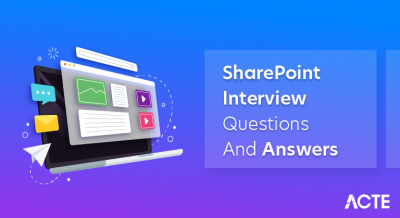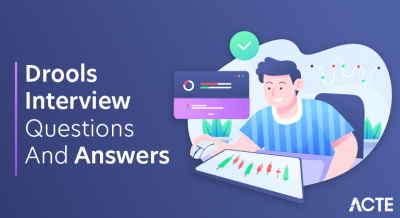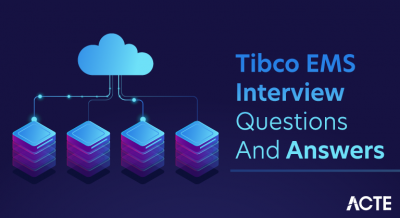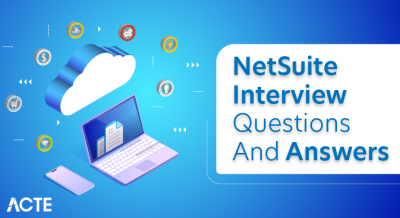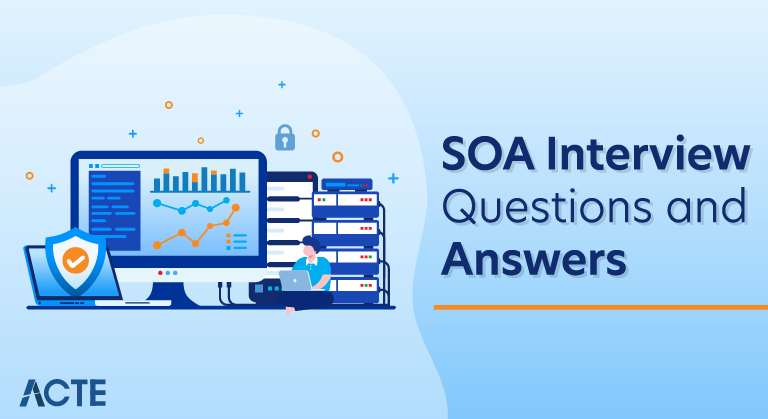
SOA is an architectural framework that arranges software systems as a set of interconnected services. These services are intended to conduct certain business operations and are capable of communicating with one another through a network. SOA encourages modularity, reusability, and flexibility in software development, allowing businesses to build agile and scalable systems by combining services to fulfill a variety of business objectives.
1. Describe SOA.
Ans:
SOA, or Service-Oriented Architecture, is a design approach and architectural style used in software development to create systems that are modular, flexible, and scalable. It is based on the concept of organizing software functionality into services, which are self-contained, reusable, and loosely coupled components.
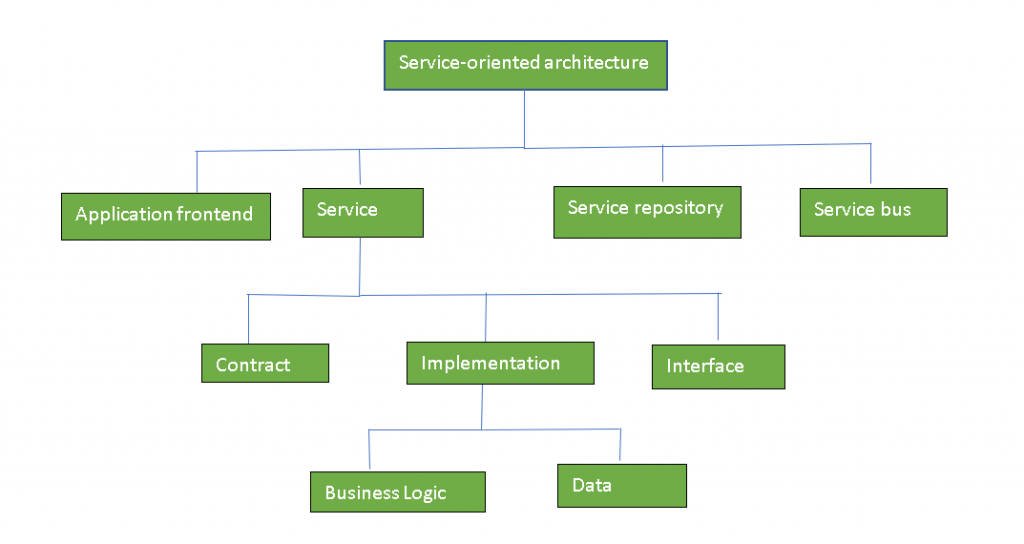
2. What are the key characteristics of SOA?
Ans:
- Complex systems are broken down into smaller, modular services.
- Services interact through well-defined interfaces, reducing dependencies.
- Services are designed to be reusable across multiple applications.
- SOA allows for the scaling of individual services to meet changing demand.
3. Describe the SOA Principles
Ans:
Service Abstraction: Services should abstract the underlying logic and implementation details, providing a clear, high-level interface to consumers.
Service Reusability: Services should be designed with reusability in mind.
Service Composability: Services should be designed to be composable, meaning they can be combined and orchestrated to create more complex processes or applications.
Service Discoverability: Services should be discoverable within the architecture, meaning that consumers can find and access them easily.
4. What are the key advantages of SOA?
Ans:
- Promotes the reuse of services across multiple applications.
- Allows services to work together, even if implemented using different technologies.
- Easily adapts to changing business requirements and integrates new services.
- Enables the scaling of individual services to handle increased demand.
- Reduces development and maintenance costs through reusability.
5. How can an Enterprise firm be transformed into a SOA?
Ans:
Transforming an enterprise business into a Service-Oriented Architecture (SOA) necessitates a strategic strategy. It starts with a thorough evaluation of existing systems and a clear connection with company objectives.
6. What does “reusable Service” mean?
Ans:
A “reusable service” is a software component or module that is intended to carry out a certain operation or function and may be applied to many applications or systems. Such services are created to be generic, self-sufficient, and autonomous, enabling their quick integration into a variety of situations without requiring significant adjustment.
7. What are some common SOA pitfalls?
Ans:
Over-Designing: Creating an overly complex and extensive SOA from the outset can lead to increased development time and cost.
Underestimating Governance: Inadequate governance can result in service redundancy and inconsistency in service standards.
Monolithic Services: Designing services that are too large and monolithic can hinder reusability and maintainability.
Inadequate Security: Neglecting security measures can expose sensitive data and services to vulnerabilities.
8. How is loose coupling achieved in SOA?
Ans:
In Service-Oriented Architecture (SOA), loose coupling is achieved by designing services and their interactions in a way that minimizes dependencies and promotes flexibility.
9. What are the two types of layers in SOA?
Ans:
- Service Provider Layer
- Service Consumer Layer
10. Describe ESB.
Ans:
The ESB acts as a centralized integration point that handles communication and data exchange between different applications and services, whether they are on-premises or in the cloud.
11. How does SOA promote reusability of software components?
Ans:
Service Abstraction: SOA abstracts implementation details, making it easier to reuse services without understanding their internals.
Modularity: SOA breaks systems into modular services, allowing independent development and maintenance.
Clear Service Contracts: Services have well-defined contracts, making it easier for consumers to understand and use them.
Interoperability: SOA enables services to work together regardless of the technologies used, fostering reuse.
12. Explain the concept of service composition in SOA.
Ans:
Service composition is a fundamental concept in Service-Oriented Architecture (SOA), a method of arranging software systems into a group of loosely linked, interoperable, and reusable services with the goal of designing and constructing software systems.
13. What is the role of service contracts in service-oriented architecture?
Ans:
Service contracts define the interfaces of services, specifying the operations a service offers, the input parameters required, and the output it provides. This interface definition includes details such as method names, data structures, and the format of messages.
14. Describe the differences between synchronous and asynchronous messaging in SOA.
Ans:
| Aspect | Synchronous Messaging | Asynchronous Messaging | |
| Response Time | Generally, response times are relatively fast, as the requester expects an immediate reply. | Response times can vary widely and are not immediate, as the requester does not wait for a reply. | |
| Coupling | Higher coupling between the requester and the service provider, as both must be available and online simultaneously. | Lower coupling between the requester and the service provider, as they do not need to be online simultaneously. | |
| Reliability | Requires a higher level of reliability since both parties need to be available for successful communication. | More forgiving of temporary unavailability, as messages can be queued and processed later. | |
| Scalability |
Can be less scalable due to the synchronous nature, as the requester may block while waiting for responses, potentially limiting concurrency. |
Typically more scalable as multiple requests can be queued and processed concurrently without blocking. | |
| Use Cases |
Well-suited for scenarios where immediate responses are required, such as online transactions or real-time processing. |
Suitable for scenarios where response time is not critical, and decoupling between components is desired, like batch processing, event-driven systems, or long-running tasks. |
15. What are the common security challenges in SOA?
Ans:
Authentication and Authorization: Managing user and service identity, ensuring only authorized entities access services, and defining granular access control policies.
Data Security: Protecting sensitive data through encryption, validation, and guarding against injection attacks like SQL or XML injection.
Message Integrity: Ensuring the integrity of messages during transit to prevent tampering or replay attacks.
16. How does SOA handle issues related to data consistency and transaction management?
Ans:
Atomic Transactions: SOA supports atomic transactions, ensuring that a sequence of operations either all succeed or all fail, maintaining data consistency.
Two-Phase Commit (2PC): In multi-service transactions, SOA employs 2PC, where services agree to commit or rollback the transaction, ensuring consistency across services.
Compensating Transactions: SOA implements compensating transactions for cases where atomic transactions are challenging, allowing for partial failure recovery and data consistency.
Saga Pattern: The Saga pattern breaks long-running transactions into smaller, manageable steps with their own compensating actions, ensuring data consistency in distributed systems.
17. Explain the concept of service versioning in SOA.
Ans:
Service versioning in Service-Oriented Architecture (SOA) is a strategy and practice for managing changes and updates to services over time while ensuring compatibility and minimal disruption to existing service consumers.
18. What strategies can be used for versioning services?
Ans:
- URI Versioning
- Media Type (Content-Type) Versioning
- Request Header Versioning
- URL Path Versioning
- Query Parameter Versioning
19. What is the purpose of a service registry in an SOA environment?
Ans:
A service registry plays a crucial role in a Service-Oriented Architecture (SOA) environment. Its primary purpose is to act as a centralized repository and directory for managing information about available services.
20. Can you differentiate between service orchestration and service choreography in SOA?
Ans:
Service Orchestration: In service orchestration, there is typically a central controller or orchestrator that coordinates and manages the flow of activities and interactions between services.
Service Choreography: Service choreography, in contrast, does not rely on a central controller. Instead, it focuses on defining the interactions and communication patterns between services.
21. What is the significance of a service catalog in an organization’s SOA strategy?
Ans:
Service Discovery: Helps stakeholders find and reuse existing services.
Transparency: Provides details about service functionality and usage guidelines.
Efficiency: Speeds up development by promoting service reuse.
Consistency: Ensures services adhere to standards and design principles.
22. Describe the benefits of using standardized communication protocols in SOA.
Ans:
Compatibility: Supports smooth transitions during service updates or versioning.
Security: Enhances overall communication security with built-in features.
Scalability: Enables services to scale without major communication changes.
Error Handling: Defines error codes and mechanisms for efficient issue resolution.
23. How does RESTful communication differ from SOAP-based communication in SOA?
Ans:
REST: The architectural design is protocol-neutral and uses Representational State Transfer (REST). Numerous underlying protocols, including HTTP, HTTPS, SMTP, and others, are available.
SOAP: A protocol-specific technique called Simple Object Access Protocol (SOAP) commonly uses HTTP or SMTP for communication.
24. What is a message broker?
Ans:
A message broker routes messages from senders to the appropriate receivers or subscribers. It uses predefined rules or routing logic to determine how and where messages should be delivered.
25. Explain how an API gateway can enhance security and control in an SOA.
Ans:
An API gateway enhances security and control in a Service-Oriented Architecture (SOA) by acting as a centralized point for managing and securing communication between clients and services.
26. What role does an ESB play in message routing and transformation within an SOA?
Ans:
An Enterprise Service Bus (ESB) plays a pivotal role in message routing and transformation within a Service-Oriented Architecture (SOA). It acts as a middleware layer that orchestrates, routes, and transforms messages between various services and applications.
27. Describe the principles of idempotence and statelessness in RESTful web services.
Ans:
Idempotence:Idempotence is a property that means making the same request multiple times has the same effect as making it once.
Statelessness: Statelessness refers to the need that each HTTP request sent by a client to a server include all the data necessary to comprehend and process the request.
28. What is the role of caching in improving the performance of services in SOA?
Ans:
In a Service-Oriented Architecture (SOA), caching is essential for enhancing the performance of services. In order to speed up data retrieval and lighten the stress on backend systems, it entails storing frequently requested or computed data in a temporary storage area, such as RAM or a dedicated cache server.
29. What are business layers in SOA?
Ans:
These layers are designed to encapsulate and manage the various aspects of an organization’s business logic and are often used to facilitate a modular and scalable approach to software development.
30. Explain the concept of a canonical data model.
Ans:
A canonical data model is a design pattern used in Service-Oriented Architecture (SOA) and data integration to establish a standardized and consistent representation of data across an organization.
31. How does service virtualization benefit SOA testing?
Ans:
- Test Independence
- Eliminates Bottlenecks
- Testing Earlier in the Lifecycle
- Cost Savings
- Control and Predictability
32. What are the key considerations for managing the lifecycle of services in SOA?
Ans:
- Service Versioning
- Service Governance
- Service Monitoring and Management
- Service Retirement and Decommissioning
33. Describe the challenges associated with ensuring backward compatibility when versioning services.
Ans:
Ensuring backward compatibility when versioning services in a Service-Oriented Architecture (SOA) can be challenging due to the need to introduce changes or updates to services while maintaining compatibility with existing clients.
34. How does an SOA approach facilitate the integration of legacy systems within an organization?
Ans:
A Service-Oriented Architecture (SOA) approach eases the integration of legacy systems within an organization by abstracting their complexity, promoting interoperability, and fostering loose coupling.
35. Explain the benefits of using message queues for asynchronous communication in SOA.
Ans:
Fault Tolerance: Messages are persisted in queues, reducing the risk of data loss in case of system failures or outages.
Temporal Decoupling: Producers and consumers can operate at different times, accommodating varying processing speeds and workloads.
Enhanced Reliability: Message queues ensure reliable message delivery, even in the presence of network issues or system downtime.
Message Prioritization: Messages can be prioritized based on business requirements, allowing critical tasks to be processed first.
36. What differentiates microservices architecture from service-oriented architecture (SOA)?
Ans:
Microservices: Microservices are small, independent, and narrowly focused services that are typically responsible for a single business capability. They are designed to be minimalistic in scope and are meant to perform a specific function.
SOA: SOA services can vary in size and complexity. They may encompass broader sets of functionalities and can be relatively larger in granularity compared to microservices.
37. Name the tools and technologies commonly used for service monitoring.
Ans:
- Application Performance Monitoring (APM) Tools
- Logging and Log Analysis Tools
- Infrastructure Monitoring Tools
- Distributed Tracing
38. How to handle service dependencies in an SOA?
Ans:
Handling service dependencies in a Service-Oriented Architecture (SOA) involves employing strategies such as service registry and discovery, API gateways, and the Circuit Breaker pattern.
39. What are some common patterns for implementing security in SOA?
Ans:
- Authentication and Authorization
- Message Security
- Access Control
- Secure Tokens and Keys Management
- Single Sign-On (SSO)
40. Explain the concept of a service mesh in microservices architecture.
Ans:
A specialized infrastructure layer called a “service mesh” is used in a microservices architecture to manage, track, and secure communication between microservices.
41. How do you handle version control and deployment of services in an SOA environment?
Ans:
In an SOA environment, version control involves a clear versioning strategy for each service using a version control system. Deployment is streamlined through CI/CD pipelines, containerization, and container orchestration, ensuring consistency, scalability, and minimal downtime across development, testing, and production environments.
42. Describe the principles of RESTful API design.
Ans:
RESTful API design follows several key principles to create scalable, efficient, and easy-to-use web services. These principles include using standard HTTP methods (GET, POST, PUT, DELETE) to represent actions, utilizing resource-based URIs to address data, ensuring statelessness, and employing a consistent and self-descriptive format for data exchange, often using JSON or XML.
43. What is service granularity?
Ans:
Service granularity refers to the size and scope of services in a software architecture, particularly in the context of microservices or service-oriented architecture (SOA). It determines how fine-grained or coarse-grained individual services are in a system.
44. How does Service Granularity impact the design of services in SOA?
Ans:
Service granularity has a significant impact on the design of services in a Service-Oriented Architecture (SOA). It influences various aspects of service design and architecture, including modularity, reusability, performance, and maintainability.
45. How does an SOA approach contribute to improved scalability and performance in a distributed environment?
Ans:
An SOA (Service-Oriented Architecture) approach enhances scalability and performance in distributed environments through service modularity and loose coupling. By breaking down functionality into discrete services, it allows for independent scaling of services to meet varying workloads. Additionally, loose coupling between services enables efficient resource allocation, reduces dependencies, and fosters parallel processing, all contributing to improved system scalability and performance.
46. Describe the role of Enterprise Integration Patterns.
Ans:
The term “Enterprise Integration Patterns” (EIP) refers to a group of design patterns that offer guidelines and recommendations for resolving issues that arise while integrating various software systems inside an organization.
47. What are some common challenges associated with managing service dependencies and ensuring service availability in SOA?
Ans:
Common challenges include handling versioning and backward compatibility of services, managing the lifecycle of services, ensuring robust error handling and fault tolerance, addressing security concerns, and effectively monitoring and managing the performance and availability of distributed services.
48. Explain how the principles of security, reliability, and scalability are applied to web services in an SOA.
Ans:
In Service-Oriented Architecture (SOA), security is ensured through authentication, authorization, and encryption mechanisms, protecting data and resources. Reliability is achieved by implementing redundancy, failover mechanisms, and error handling to ensure consistent service availability. Scalability is attained by designing services to be modular and horizontally scalable, allowing them to handle varying loads through load balancing and resource allocation.
49. How does the use of containerization technologies like Docker with SOA principles?
Ans:
The utilization of containerization technologies such as Docker harmonizes seamlessly with SOA principles. Docker containers encapsulate services and their dependencies, fostering modularity and independent service development, deployment, and management.
50. Describe the concept of a service repository in SOA.
Ans:
Service repository is a centralized or distributed repository that serves as a catalog or registry of available services within an organization. Its primary purpose is to facilitate the discovery, reuse, and management of services across various applications and systems.
51. What is role of service repository in service governance in SOA?
Ans:
- Service Discovery and Visibility
- Version Management
- Policy Enforcement
- Metadata and Documentation
- Service Lifecycle Management
52. Explain the role of service-level agreements (SLAs) in service governance.
Ans:
Service-Level Agreements (SLAs) play a crucial role in service governance within a Service-Oriented Architecture (SOA) ecosystem. These agreements define the expectations and commitments between service providers and consumers regarding the quality of service delivery.
53. Explain the benefits of implementing event-driven architecture in SOA.
Ans:
Real-time Responsiveness: EDA enables services to react to events as they occur, allowing for real-time responsiveness.
Loose Coupling: EDA promotes loose coupling between services. Services don’t need to be aware of each other; they only need to publish and subscribe to events.
Scalability: EDA allows for horizontal scalability by distributing event processing across multiple nodes or microservices.
Flexibility and Extensibility: New services can be easily integrated into the architecture by subscribing to relevant events.
54. Explain the difference between a service and a component in SOA.
Ans:
Service: Services are designed to be autonomous, self-contained entities that can function independently. They encapsulate specific business logic or functionality and can operate without being tightly coupled to other services.
Component: Components are generally finer-grained software elements that make up an application. They can represent smaller, more specialized units of functionality within an application.
55. What are the key characteristics of a well-designed service in SOA?
Ans:
Interoperability: Services in SOA are meant to interact with other services and systems.
Loose Coupling: A well-designed service minimizes dependencies on other services, allowing it to evolve independently.
Discoverability: Services should be discoverable within the SOA ecosystem.
Granularity: The granularity of a service should be appropriate for its intended purpose.
56. Explain the importance of service contracts in SOA.
Ans:
Service contracts are a cornerstone of Service-Oriented Architecture (SOA) because they establish the terms of engagement between services. They define the rules, protocols, and expectations that govern how services interact. This is vital for ensuring interoperability, enabling loose coupling, promoting reusability, and enforcing governance and security policies.
57. What are the common protocols used for service communication in SOA?
Ans:
- Simple Object Access Protocol (SOAP)
- Representational State Transfer (REST)
- Web Services Description Language (WSDL)
- Universal Description, Discovery, and Integration (UDDI)
- JSON-RPC and XML-RPC
58. How do you determine the granularity of services in an SOA?
Ans:
Determining service granularity in a Service-Oriented Architecture (SOA) involves finding the ideal balance between overly fine-grained and excessively coarse-grained services. It requires considering business functionality, reusability, and independence, while also factoring in manageability, performance, and adaptability to future changes.
59. What is a WSDL?
Ans:
The interface and functionality of web services are described using the XML-based Web Services Description Language. By defining the actions a service may carry out, the data types it utilizes, and how to access it, it offers a standardized method for software components to interact with one another across a network.
60. What is the role of RESTful APIs in SOA?
Ans:
RESTful APIs play a pivotal role in a Service-Oriented Architecture (SOA) by providing a lightweight and interoperable means of communication between services. They adhere to the principles of Representational State Transfer (REST), emphasizing resource-oriented interactions using standard HTTP methods like GET and POST.
61. How do you handle versioning of services in an SOA environment?
Ans:
Handling versioning of services in an SOA environment is crucial for managing changes without disrupting existing clients. A common approach is to incorporate version numbers into the service’s URL or header, allowing multiple versions to coexist.
62. What is service orchestration?
Ans:
Service orchestration is a fundamental concept in Service-Oriented Architecture (SOA) and workflow management. It involves the coordination and sequencing of individual services to accomplish a specific business process or task.
63. What is service choreography?
Ans:
Service choreography is another key concept in Service-Oriented Architecture (SOA) that focuses on the interaction and coordination of services without the need for a central controller. In service choreography, each participating service communicates with others through predefined message exchanges and protocols.
64. Explain the concept of message-driven architecture in SOA.
Ans:
Message-driven architecture in Service-Oriented Architecture (SOA) is an architectural style where communication and interaction between services are based on asynchronous messages. Instead of direct, synchronous calls, services send and receive messages through a message broker or middleware.
65. What is data mapping?
Ans:
Data mapping is the process of defining the relationships and transformations between data fields or attributes from one data source or format to another. It is commonly used in data integration, ETL (Extract, Transform, Load) processes, and data migration scenarios.
66. Why is Data mapping important in service integration?
Ans:
- Data Harmonization
- Interoperability
- Data Transformation
- Error Handling
- Versioning
67. How can you ensure message reliability and delivery in a distributed SOA system?
Ans:
Ensuring message reliability and delivery in a distributed Service-Oriented Architecture (SOA) system involves implementing robust messaging patterns and mechanisms. Key strategies include using message queues or brokers to handle asynchronous communication, employing acknowledgment mechanisms to confirm message receipt, implementing retry and error-handling mechanisms to address delivery failures, and leveraging distributed transactional systems for atomicity.
68. What is service governance?
Ans:
Service governance is a set of policies, processes, and practices that ensure the effective management, control, and optimization of services within a Service-Oriented Architecture (SOA). It encompasses aspects such as service discovery, versioning, security, performance monitoring, and lifecycle management.
69. Why is service governance necessary in SOA?
Ans:
Consistency: It enforces consistent standards, naming conventions, and best practices across services, ensuring that all services follow a common set of rules and guidelines.
Reusability: Service governance promotes the creation of reusable services.
Interoperability: Service governance helps ensure that services can work together seamlessly.
70. What are service policies?
Ans:
Service policies are a set of rules, guidelines, and configurations that define how a service should behave and interact within a Service-Oriented Architecture (SOA). These policies cover various aspects such as security, access control, message validation, and quality of service (QoS).
71. How service policies are they enforced in an SOA environment?
Ans:
Service policies in an SOA environment are enforced through a combination of mechanisms and tools. Typically, a policy enforcement point (PEP) is responsible for implementing and enforcing policies.
72. How do you ensure security in a service-oriented architecture?
Ans:
Ensuring security in a Service-Oriented Architecture (SOA) involves a multi-layered approach. It begins with strong access controls and authentication mechanisms, ensuring that only authorized users and services can access resources. Additionally, data encryption and secure communication protocols like HTTPS protect data in transit.
73. Describe the role of a service registry in SOA.
Ans:
Service Discovery: The service registry acts as a lookup mechanism, allowing service consumers to discover available services.
Service Metadata: It stores and manages metadata about each service, including its name, description, version, location, and dependencies.
Endpoint Management: The registry keeps track of service endpoints, which are the specific locations or addresses where services can be accessed.
Service Versioning: Service registries often support versioning, allowing multiple versions of a service to coexist.
Load Balancing and Failover: In some cases, service registries can include load balancing and failover capabilities.
74. What is service monitoring in an SOA ecosystem?
Ans:
Service monitoring in a Service-Oriented Architecture (SOA) ecosystem refers to the process of systematically observing, tracking, and analyzing the performance, health, and behavior of services and the interactions between them.
75. How service monitoring can be implemented in an SOA ecosystem?
Ans:
Define Monitoring Objectives: Clearly define what aspects of the SOA ecosystem you need to monitor, such as performance, availability, security, or compliance.
Select Monitoring Tools: Choose appropriate monitoring tools and platforms that align with your monitoring objectives.
Instrument Services: Instrument services with monitoring agents or code hooks that collect relevant data, such as response times, error rates, and resource utilization.
Centralized Monitoring Hub: Set up a centralized monitoring hub or system where data from various services and components are collected, aggregated, and analyzed.
76. How do you design services to be scalable in an SOA environment?
Ans:
Designing services for scalability in an SOA environment involves creating stateless services to enable horizontal scaling, implementing load balancing to evenly distribute traffic, and designing services with loose coupling to allow independent scaling without causing cascading failures. These practices ensure that the services can handle increased workloads and adapt to changing demands while maintaining performance and reliability.
77. Explain the concept of load balancing in SOA.
Ans:
Load balancing in a Service-Oriented Architecture (SOA) is the practice of evenly distributing incoming requests or traffic across multiple instances of a service. This ensures that no single service instance becomes overwhelmed with requests, optimizing resource utilization and improving the overall system’s performance, availability, and scalability.
78. What are some common techniques for optimizing the performance of services in an SOA system?
Ans:
- Caching
- Asynchronous Processing
- Service Decomposition
- Load Balancing
- Database Optimization
- Circuit Breaker Pattern
79. How can caching be used to improve the performance of services?
Ans:
Caching can significantly enhance the performance of services in an SOA by storing frequently accessed data or computed results temporarily. When a service receives a request for data or an operation that is already cached, it can retrieve the cached result much faster than generating it a new.
80. What are the stages in the service lifecycle in SOA?
Ans:
- Service Identification and Definition
- Service Design
- Service Development
- Service Testing
- Service Deployment
81. How do you handle service retirement in an SOA ecosystem?
Ans:
Handling service Retirement in a SOA environment requires a systematic method to facilitate a seamless transition while avoiding disturbances. This procedure generally include identifying services to be retired, alerting relevant stakeholders, allowing sufficient time for users to move to alternative services or versions, and decommissioning the retired service after it is no longer in use.
82. How do you handle service deprecation in an SOA ecosystem?
Ans:
Handling service deprecation in a Service-Oriented Architecture (SOA) ecosystem involves a carefully planned and communicated process to phase out or retire a service while minimizing disruption to service consumers.
83. Explain the concept of service discovery in service lifecycle management.
Ans:
Service discovery is a fundamental concept in service lifecycle management within a Service-Oriented Architecture (SOA). It refers to the process of dynamically identifying and locating available services within an SOA ecosystem.
84. What role does documentation play in the service lifecycle?
Ans:
Clarity and Understanding: Documentation provides clear and comprehensive information about services, helping stakeholders understand their functionality, purpose, and usage.
Onboarding: It aids in onboarding new developers and service consumers, providing them with the necessary information to start using services effectively.
Interoperability: Detailed documentation ensures that services can interoperate seamlessly by specifying service contracts, data formats, and communication protocols.
85. What are the advantages of SOA over a monolithic architecture?
Ans:
- SOA’s modular approach simplifies development, maintenance, and updates.
- SOA allows independent scaling of services for better resource allocation.
- Loose coupling in SOA enhances adaptability to changing business needs.
- SOA encourages the creation of reusable services, reducing development effort.
- Standardized interfaces promote seamless integration with diverse systems.
86. What are Resuable services?
Ans:
A reusable service is an independent, discoverable, stateless, and reusable capability that has the necessary granularity and can be included into a composite application or set of services.
87. Define Mediator in SOA.
Ans:
The Mediator is in charge of connecting components that offer various interfaces inside a SOA composite application. Additionally, the Mediator is capable of carrying out tasks like filtering and choosing routes. As you connect components to the Mediator, you have the option to define the interface now, select an existing interface, or define it later using JDeveloper’s composite editor.
88. What are the difference between ESB and Mediator?
Ans:
| ESB | Mediator |
|---|---|
| ESB is a comprehensive middleware solution designed to handle various aspects of service integration and communication within an SOA. | It acts as a central hub for routing, transformation, mediation, and orchestration of messages between services. |
| A Mediator is a specific design pattern used to facilitate communication between two or more components or objects. | In the context of SOA, a Mediator is often a lightweight component responsible for message transformation and routing between services, typically within a specific mediation flow. |
89. What are the differences between concrete and abstract WSDL?
Ans:
Concrete WSDL: Concrete WSDL, also known as a service or endpoint WSDL, provides specific details about a particular instance or implementation of a web service.It defines the technical aspects of how a client can communicate with a particular instance of the service.
Abstract WSDL: Abstract WSDL, also known as a contract or interface WSDL, defines the abstract interface of a web service without specifying implementation details.
It describes what operations the service provides, the input and output messages, and the message exchange patterns.
90. Difference between URI and URL
Ans:
| URI | URL |
|---|---|
| A URI is a general phrase that refers to both URLs and URNs (Uniform Resource Names). | It is a short string of characters that acts as a resource’s special identification number. |
| A particular kind of URI called a URL describes how to reach a resource in addition to identifying it. | The protocol (e.g., HTTP, FTP), the domain name or IP address, a port number, the path to the resource on the server, and optional query parameters or fragments all make up a URL in most cases. |
91. Describe web services.
Ans:
Web services are a standardized technology for enabling communication and interoperability between different software applications over the internet. They allow systems written in different programming languages and running on various platforms to exchange data and functionality seamlessly.
92. Describe a throw activity.
Ans:
It represents a point in the process where information, a message, or an event is sent or “thrown” to initiate a specific action or task. Throw activities are typically used in combination with “catch activities” to model event-driven processes, where the process flow responds to external events or messages.
93. What is SOA testing?
Ans:
SOA (Service-Oriented Architecture) testing refers to the process of evaluating and validating the functionality, performance, security, and reliability of services and their interactions within an SOA ecosystem.
94. Give an example for SOA.
Ans:
Healthcare organizations utilize SOA to integrate electronic health records (EHRs), billing systems, appointment scheduling, and telemedicine services. This integration improves patient care, streamlines administrative processes, and ensures data accuracy.
95. How can the SOA’s transaction timeouts be increased?
Ans:
To increase transaction timeouts in a Service-Oriented Architecture (SOA), you typically need to adjust configuration settings at various levels of your architecture. This includes modifying settings in the application server, middleware, and potentially within individual services.


